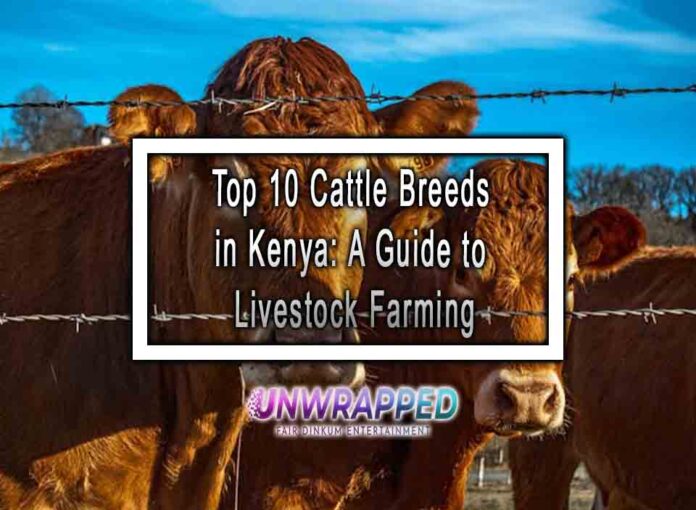Kenya’s agricultural sector relies heavily on livestock farming, with cattle playing a vital role in both food security and economic stability. From producing milk and beef to providing draft power, cattle are essential to Kenyan farmers and pastoralists. With its diverse climate, Kenya is home to indigenous and exotic cattle breeds that thrive in different environments, from arid savannahs to fertile highlands.
This guide highlights the top 10 cattle breeds in Kenya, detailing their characteristics, uses, and contributions to the country’s agricultural success.
Top 10 Cattle Breeds in Kenya
1. Zebu
- Key Characteristics: Medium size, hump on the back, hardy and disease-resistant.
- Primary Use: Dual-purpose (beef and milk) and draft power.
- Fun Fact: Indigenous to Kenya, Zebu cattle are exceptionally resilient to drought and disease, making them the backbone of livestock farming in arid and semi-arid regions.
2. Friesian
- Key Characteristics: Black-and-white coat, large frame, and high milk yield.
- Primary Use: Dairy production.
- Fun Fact: Friesians are popular in Kenya’s highlands, producing up to 6,000 liters of milk annually under optimal conditions.
3. Boran
- Key Characteristics: White or grey coat, muscular build, and heat tolerance.
- Primary Use: Beef production.
- Fun Fact: Originating from Kenya’s Borana community, Boran cattle are renowned for their ability to gain weight quickly and thrive on low-quality forage, making them ideal for pastoral systems.
4. Ayrshire
- Key Characteristics: Red-and-white coat, medium size, and high-quality milk.
- Primary Use: Dairy production.
- Fun Fact: Ayrshire cows are favored in Kenya for their milk’s high butterfat content, perfect for making cream and other dairy products.
5. Sahiwal
- Key Characteristics: Reddish-brown coat, medium frame, and gentle temperament.
- Primary Use: Dairy production and crossbreeding.
- Fun Fact: Imported from South Asia, Sahiwal cattle are well-adapted to Kenya’s heat and are often crossbred with Friesians to improve milk yields.
6. Guernsey
- Key Characteristics: Light brown or fawn coat with white patches, medium size, and docile nature.
- Primary Use: Dairy production.
- Fun Fact: Known as the “golden cow” for its rich, yellowish milk, Guernsey cattle are highly valued for their milk’s unique flavor and high butterfat content.
7. Charolais
- Key Characteristics: White or cream-colored coat, large size, and muscular build.
- Primary Use: Beef production.
- Fun Fact: Charolais cattle are increasingly popular among commercial farmers in Kenya for their rapid growth and high-quality beef.
8. Jersey
- Key Characteristics: Light brown coat, small frame, and high butterfat milk.
- Primary Use: Dairy production.
- Fun Fact: Jersey cows thrive in Kenya’s highlands, producing milk that’s ideal for making premium cheeses and yogurt.
9. Nguni
- Key Characteristics: Multicolored coat with unique patterns, medium size, and hardy disposition.
- Primary Use: Beef production and cultural significance.
- Fun Fact: Originally from southern Africa, Nguni cattle are prized for their resilience and are often used in Kenya for ornamental purposes and traditional ceremonies.
10. Fleckvieh (Simmental)
- Key Characteristics: Red-and-white coat, large frame, and high productivity.
- Primary Use: Dual-purpose (beef and dairy).
- Fun Fact: Fleckvieh cattle are popular in Kenya for their versatility, offering both high milk yields and quality beef, making them a great choice for smallholder farmers.
Interesting Facts About Cattle Farming in Kenya
- Indigenous Breeds: Indigenous breeds like Zebu and Boran are uniquely adapted to Kenya’s climate, thriving in harsh conditions with minimal resources.
- Dairy Industry: Kenya is one of Africa’s largest producers of milk, with breeds like Friesian and Ayrshire leading the dairy sector.
- Pastoralism: In arid and semi-arid regions, pastoralist communities rely on hardy breeds like Zebu and Boran for their livelihoods.
- Crossbreeding Programs: Farmers frequently crossbreed indigenous and exotic breeds to improve productivity and adaptability.
Frequently Asked Questions
Q: Which cattle breed is best for dairy farming in Kenya?
A: Friesians are the most popular dairy breed in Kenya due to their high milk yields, while Ayrshire and Jersey cows are valued for their milk’s butterfat content.
Q: What is the most popular beef breed in Kenya?
A: Boran cattle are highly prized for beef production, thanks to their ability to thrive in harsh conditions and produce high-quality meat.
Q: Are there indigenous cattle breeds in Kenya?
A: Yes, Zebu and Boran cattle are indigenous to Kenya and are widely used for both subsistence and commercial farming.
Q: How do Kenyan farmers manage cattle in arid regions?
A: Farmers rely on hardy breeds like Zebu and Boran, rotational grazing, and water conservation practices to sustain cattle in arid climates.
Conclusion: The Backbone of Kenyan Agriculture
Cattle farming is a vital part of Kenya’s agricultural landscape, providing food, income, and cultural significance to millions. From the hardy Zebu and Boran to high-yielding dairy breeds like Friesian and Ayrshire, these cattle are essential to the nation’s economic and agricultural success.
As Kenya continues to develop its livestock sector through crossbreeding and sustainable practices, these breeds will remain at the heart of its agricultural growth. Whether producing rich milk or tender beef, Kenya’s cattle breeds exemplify resilience, adaptability, and productivity.
See Also: Top 10 Cattle Breeds in Nigeria: Beef and Dairy Breeds Every Farmer Should Know










